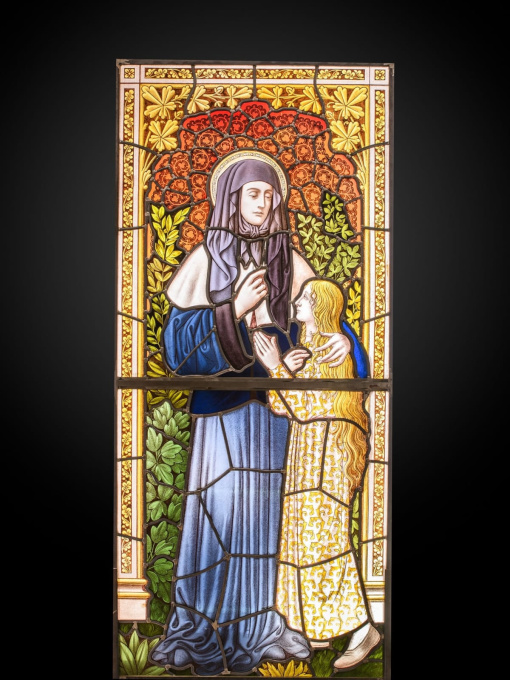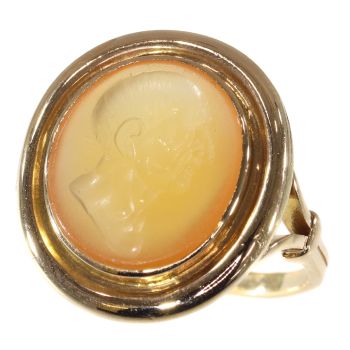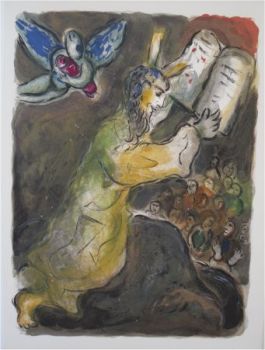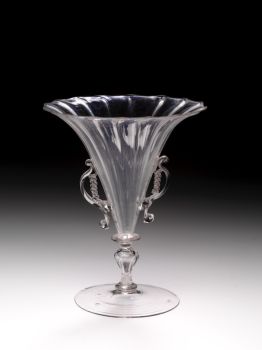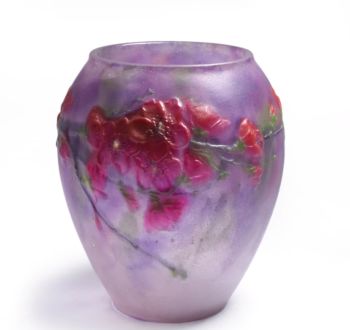EIGHT NEO-GOTHIC STAINED GLASS WINDOWS WITH SUSPENSION EYELET, 19th C, BELGIUM. 1850 - 1900
Artista Desconhecido
CopoVitral
163 ⨯ 73 cm
Preço em pedido
Spectandum Gallery
- Sobre arteIn the 19th century, the romantic surge revived interest in medieval art, leading to a renewed admiration for the stained glass windows of Gothic churches. New churches and monasteries were erected in a neo-Gothic style, where stained glass played a crucial role. Stained glass workshops thrived in various Belgian cities, with notable artists such as Jean-Baptiste Capronnier in Schaerbeeck, Samuel Coucke and Henri & Jules Dobbelaere in Bruges, Jean-François Pluys in Mechelen, as well as the workshop of Jean-Baptiste Bethune and Arthur Verhaegen in Ghent. Artists like Charles De Groux and Constantin Meunier also contributed as designers of cartoons for the stained glass. The stained glass in question has been carefully cleaned and placed back in new lead frames, giving it an excellent current condition. A hanging loop allows for easy hanging, and it is also possible to position it vertically.
Saint Nicholas of Bari (born in Patara around 260-270 and died in Myra around 335-337) is known for his generosity towards children, bringing them gifts on December 6th. He is also famous for bringing back to life three theology students who had been murdered by an innkeeper and preserved in a brine container. The two-fingered blessing gesture in his representation refers to the two natures of Christ, divine and human.
Bernard of Clairvaux (born in Fontaines in 1090 and died in Clairvaux in 1153) embraced monastic life at the age of 21 by joining the monastery of Cîteaux in 1112. Endowed with remarkable intellectual abilities and remarkable eloquence, he was tasked by the abbot to found the monastery of Clairvaux. His advice was sought by many ecclesiastical and lay leaders, and he contributed to the expansion of the Cistercian order throughout Europe. Recognized as a Doctor of the Church, Bernard of Clairvaux wrote numerous treaties and sermons, in addition to establishing a new rule for the Knights Templar. His main concern was the discipline of the clergy, which led him to write a spiritual manual for priests and bishops. Considered a genuine mystic, he saw the union of the human soul with God as the ultimate purpose of life. Legend has it that he received a vision of the Virgin Mary offering him her mother's milk to fortify him. In artistic representations, Saint Bernard is usually depicted with an abbot's staff and a book containing the Cistercian rule, reflecting his influence and spiritual contributions. His mystical vision is also a common motif.
Saint Martin (born in Szombathely around 316 and died in Candes around 397) is famous for his act of charity where he divided his cloak in two with a beggar. However, in this stained glass, the artist chose a less common iconographic representation. Saint Martin is depicted as a bishop, wearing a miter and holding an episcopal staff. According to legend, Martin was lured to Tours under false pretenses to be consecrated as bishop. Refusing to assume this ecclesiastical office, he hid in a barn with some geese. However, the birds' chirping betrayed his presence, and he eventually received his episcopal consecration. The presence of a goose at the saint's feet clearly refers to this legendary episode.
Jan Berchmans (born in Diest in 1599 and died in Rome in 1621) was the eldest of five siblings. When his mother fell seriously ill, he initially cared for her, but at the age of nine, he was taken in by the town's priest. After a few years, he went to Mechelen to become a servant to a canon, which also allowed him to begin his studies at the seminary for priests. Later, he joined the Jesuits of Mechelen and obtained their permission to study philosophy in Rome. In the Eternal City, he devoted himself to teaching the faith to children in the popular neighborhoods. He died of illness at the age of 22. Saint Jan Berchmans is now venerated as the patron saint of schoolchildren and students.
Saint Roch (born in Montpellier around 1295-1300 and died around 1327-1380) is famous for being born with a birthmark in the shape of a cross on his left hip, interpreted as a divine sign. After the death of his parents, he distributed his wealth to the poor and went on a pilgrimage, dedicating his life to caring for plague victims. It is said that he healed some of them by making the sign of the cross, earning him the invocation as a protector against the plague.
Saint Clare of Assisi (born in Assisi in 1194 and died in 1253) founded the monastic order of the Poor Clares and became abbess in 1216. She led a life of austerity and isolation from the world with the sisters of her order. When the city of Assisi was threatened by the Saracen army, she fervently prayed before a monstrance for the safety of her monastery and the city, which helped repel the enemy without causing harm. The stained glass represents her with her radiant monstrance.
Charles Borromeo (born in Milan in 1538 and died in 1584) grew up in a noble family and reached remarkable ecclesiastical heights from a young age, becoming cardinal and archbishop of Milan at only 24. His writings played a crucial role in implementing the Church reforms stemming from the Council of Trent. Notably, he published a new catechism and influenced the construction of Baroque churches with his work on the design of religious buildings entitled "Instructiones Fabriacae et Supellectilis Ecclesiasticae." During the plague epidemic that struck his diocese in 1576, Charles Borromeo devoted himself to caring for the sick, earning a reputation for being invoked by those afflicted with serious illnesses.
Angela Merici (born in Desenzano del Garda in 1474 and died in Brescia in 1540), a devoted Italian, taught religion, healthcare, and household skills to young women. She is the originator of the Ursuline monastic community, which played a crucial social role in founding schools and orphanages. Saint Angela died in Brescia in 1540, hence the representation in the stained glass of the saint accompanied by a young girl at her side. - Sobre artista
Pode acontecer que um artista ou criador seja desconhecido.
Algumas obras não devem ser determinadas por quem são feitas ou são feitas por (um grupo de) artesãos. Exemplos são estátuas dos tempos antigos, móveis, espelhos ou assinaturas que não são claras ou legíveis, mas também algumas obras não são assinadas.
Além disso, você pode encontrar a seguinte descrição:
•"Atribuído a …." Na opinião deles, provavelmente uma obra do artista, pelo menos em parte
• “Estúdio de…” ou “Oficina de” Em sua opinião um trabalho executado no estúdio ou oficina do artista, possivelmente sob sua supervisão
• "Círculo de ..." Na opinião deles, uma obra da época do artista mostrando sua influência, intimamente associada ao artista, mas não necessariamente seu aluno
•“Estilo de…” ou “Seguidor de…” Na opinião deles, um trabalho executado no estilo do artista, mas não necessariamente por um aluno; pode ser contemporâneo ou quase contemporâneo
• "Maneira de ..." Na opinião deles, uma obra no estilo do artista, mas de data posterior
•"Depois …." Na opinião deles uma cópia (de qualquer data) de uma obra do artista
• “Assinado…”, “Datado…” ou “Inscrito” Na opinião deles, a obra foi assinada/datada/inscrita pelo artista. A adição de um ponto de interrogação indica um elemento de dúvida
• "Com assinatura ….”, “Com data ….”, “Com inscrição ….” ou “Tem assinatura/data/inscrição” na opinião deles a assinatura/data/inscrição foi adicionada por outra pessoa que não o artista
Você está interessado em comprar esta obra de arte?
Artwork details
Related artworks
- 1 - 4 / 12
- 1 - 4 / 24
Artista Desconhecido
The Stamford Raffles Secretaires.1800 - 1813
Preço em pedidoZebregs & Röell - Fine Art - Antiques
Artista Desconhecido
UM MODELO JAPONÊS DE UM NORIMONO, UM PALANQUIM1650 - 1700
Preço em pedidoZebregs & Röell - Fine Art - Antiques
Artista Desconhecido
A Japanese bronze Hu flower vase, Edo / Meiji, 19th century19th century
Preço em pedidoMenken Works of Art
1 - 4 / 24Marc Chagall
And Mozes saw the burdens of his Brethren1952 - 1989
Preço em pedidoArthouse Marc Chagall
Artista Desconhecido
UITGEBREIDE FEESTDAGENIKOON MET PASSIECYCLUS19th century
Preço em pedidoHeutink Ikonen
1 - 4 / 24Artista Desconhecido
Copo de beber Cristallo façon de Venise1600 - 1650
Preço em pedidoPeter Korf de Gidts - Antiquairs
René Lalique
Um vaso "Fougeres" verde profundo muito raro projetado por R. Lalique1912
€ 8.950Lennart Booij Fine Art and Rare Items
 Com curadoria de
Com curadoria deSilla Scheepens
1 - 4 / 24Artista Desconhecido
Pair of 19th C French Taxidermy Dioramas1860 - 1890
Preço em pedidoSpectandum Gallery
1 - 4 / 12



